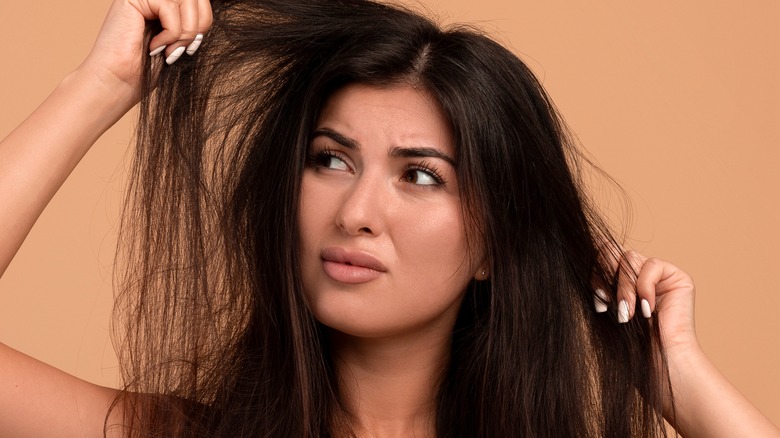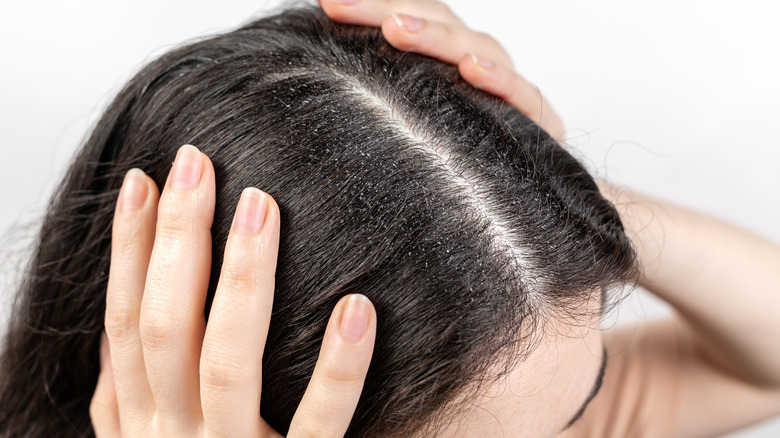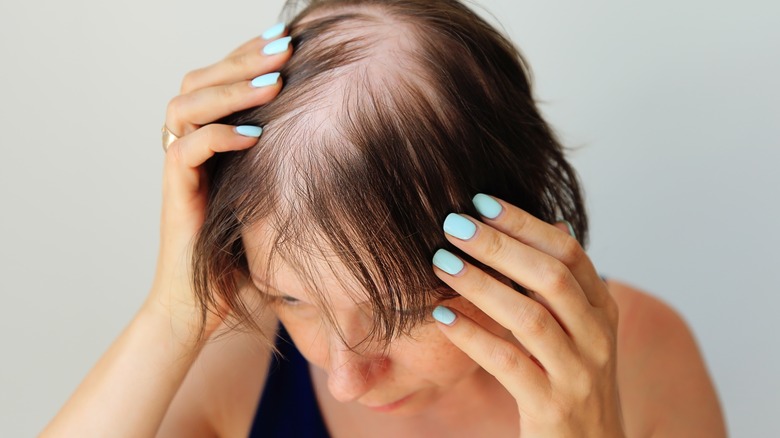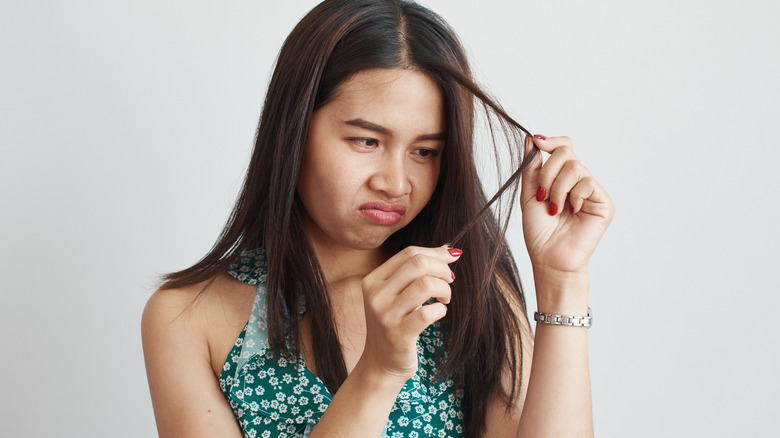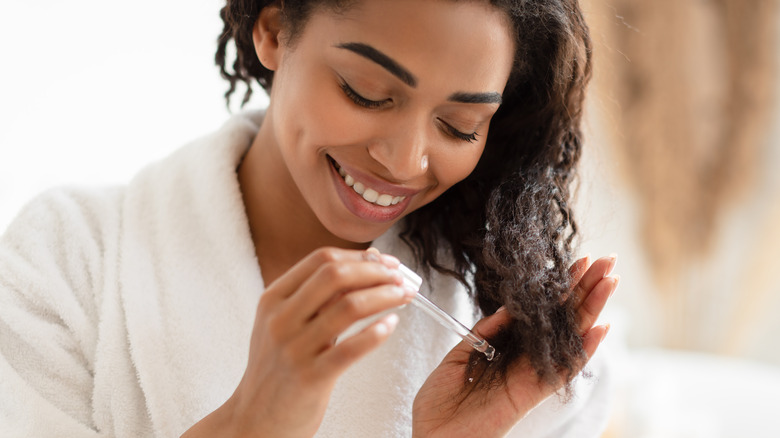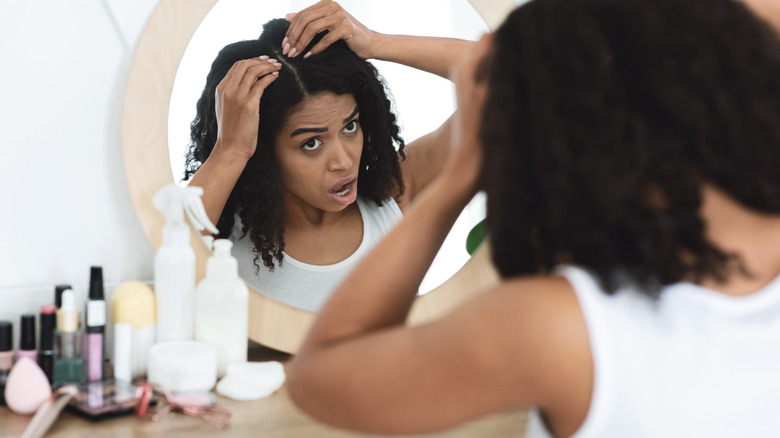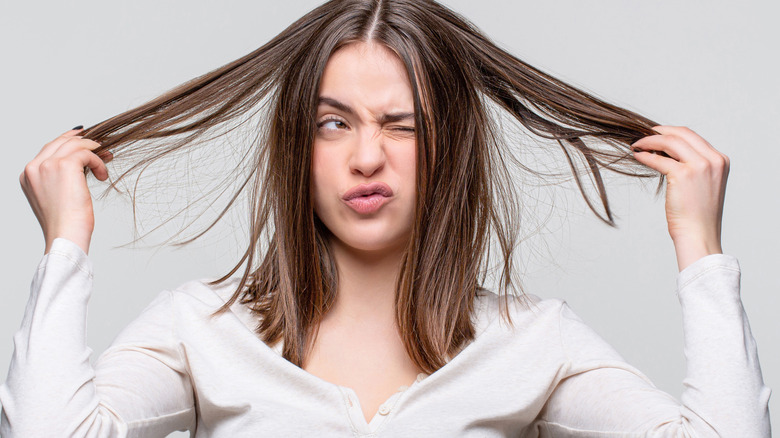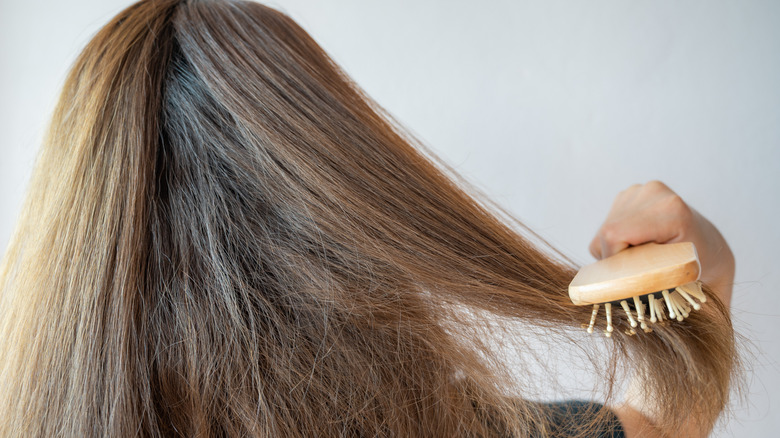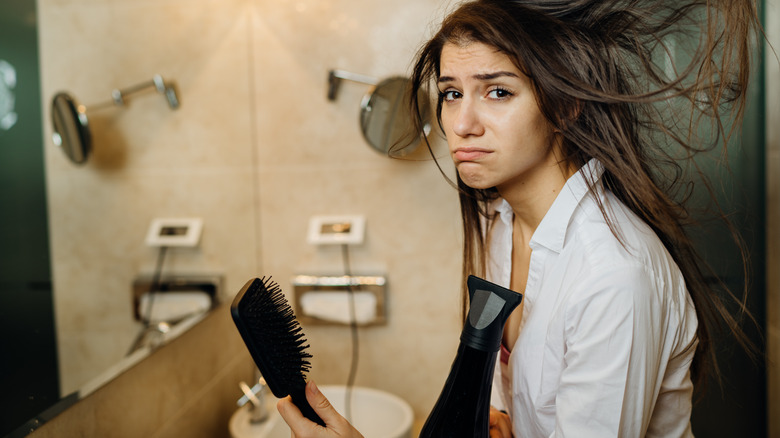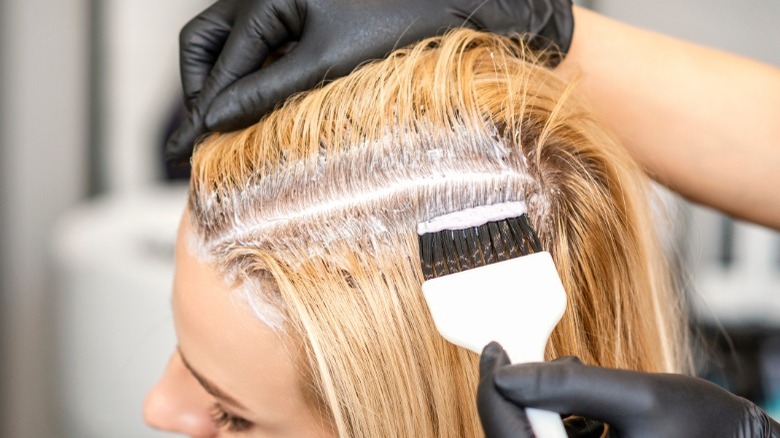Hair Concerns You Shouldn't Ignore If You Want Healthy Tresses
We may receive a commission on purchases made from links.
Do you dream of having beautiful, healthy hair? It's probably safe to say we all share this dream. Who doesn't want to have the perfect, shiny hairdo day in and day out? Unfortunately, that isn't the reality for many of us who struggle with hair woes such as frizz, split ends, and dryness.
If you struggle with any hair concerns that leave you with limp, lifeless hair, the good news is there is oftentimes a cure to mend your sorry strands and bring them back to life. External factors in our control usually cause the most common hair concerns that we see. So, you might need to put down the curling iron and — as much as you don't want to — get a haircut. We promise you, your hair will thank you for it. There are many hair concerns that should throw some red flags but it's just about identifying them and researching the best ways to treat them.
Dandruff
One of the most common and pesky hair concerns people struggle with is dandruff. Not to be confused with a dry scalp, dandruff looks like loose white scales on the hair. But what is the reason behind it? Dandruff is a result of excess oil production on the scalp, typically combined with an overgrowth of yeast called Malassezia, according to Allure.
There are actually several offenders that can contribute to dandruff. Are you a once-a-week hair washer? That could be your culprit. Washing once a week allows excess oil to form on the scalp, which can lead to dandruff. In other cases, it might be the hair products you use. Some hair products can dry out the scalp or create excess oil and kick dandruff into high gear. Other causes may be stress or even weather-related.
To find a cure for your dandruff woes, the first thing to do is figure out the cause. Once you figure out the reason behind the problem, you can create an action plan to help manage the situation.
Hair loss
We all lose hair every day. Shedding is normal. According to Cosmopolitan, we lose about 80 strands of hair daily. However, significant hair loss is an entirely different hair concern. We're not talking about the few strands you find in your hair brush. We're talking about substantial thinning and loss of hair. While hair loss is more common in men, many women struggle with this issue as well (via Healthline). The thing about hair loss is there are so many potential causes, as well as two main types of hair loss: genetic and reactive.
Genetic hair loss is exactly what it sounds like — it results from a genetic trait passed down from your parents. Unfortunately, there is no cure for genetic hair loss, but there are treatments that can help slow the rate of thinning (via Health Navigator New Zealand).
Reactive hair loss is caused by some sort of trigger, such as hormonal imbalance, stress, thyroid issues, or poor diet. The good news with reactive hair loss is there is typically a solution to stop it. According to hair loss expert and leading Trichologist Anabel Kingsley (via Cosmopolitan), reactive hair loss is most often self-eliminating so you can get back to having gorgeous, luscious locks with a little TLC.
Dry hair
Do you feel like your hair is screaming for some hydration? Dry hair is another hair concern many people deal with. So what causes dry hair? Well, there are several reasons why your ends might be as dry as the Sahara.
According to Vogue, the number one culprit behind dry hair is heat styling. We know you love having beautifully styled hair, but do yourself a favor and at least use a heat protectant on your precious locks. If you can, style your hair with heat less and give your strands a break. Another offender behind dry hair is color damage. Color-treated hair often becomes compromised during the process, resulting in dry and brittle hair. Other common causes behind dry hair include environmental conditions, age, and health issues.
So, what is the solution to dried-out hair? Hydration, hydration, hydration! Treatments such as hair masks, conditioning, hair oils, and serums are your new BFFs.
Split ends
On the top of the list of hair concerns, split ends reign supreme. Every person with hair experiences split ends, and much to our dismay, there is no way around them. Split ends come from pretty much everything we do to our hair, like brushing, heat styling, dying, sleeping, etc.
So, what can you do to manage your split ends? Well, the best answer, which most people don't want to hear, is drumroll ... regular trims! There is no better way to manage your split ends than getting regular trims from your stylist. Now, we realize this isn't everyone's favorite solution. Some of us have a hard time committing to cutting off any part of our hair. For those who can't commit to regular cuts, there are other ways to help your split ends, or at least minimize their appearance.
Treatments such as serums and leave-in conditioners can help prevent split ends, but keep in mind they won't actually repair split ends after they occur. According to Allure, once the end splits, there is no repairing.
Oily hair and scalp
On the other end of the follicle spectrum is an oily scalp and hair, another common concern that leaves locks looking greasy and, let's face it, not cute. Not to mention, it's really difficult to style oily hair.
Our scalps produce an oily substance called sebum, which helps improve the skin's barrier on the scalp to protect it from damage, per Allure. However, if too much sebum is produced, it leads to a greasy scalp and oily hair. Like many other hair problems, a few factors contribute to oily hair. According to Byrdie, oily hair can be hormone related, a result of styling products, diet, or a dry scalp which causes it to overproduce oil.
Again, the treatment solution lies in the cause. So, to remedy oily hair, the cause needs to be determined first. Start by switching up your hair care routine by trying a clarifying shampoo, brushing your hair regularly, and going from there.
Dull hair
If you notice your hair doesn't look lustrous and shiny, you're probably dealing with dull hair. With this common hair concern, the hair looks limp, matte, and dry. According to Hairstory, our hair strands are covered with a cuticle layer. When the cuticle lays flat, the hair looks polished, shiny, and sleek. When the cuticle is raised, the hair looks dull.
Dull hair can come from many factors, many of which can be easily fixed. Here are some of the common causes of dull hair, according to Hairstory:
- Product buildup
- Sun damage
- Hard water
- Excessive heat styling
- Overprocessed hair
- Hormonal changes
- Lack of brushing
- Improper use of hair products
If you suffer from dull hair, there are several steps you can take to bring the shine back to your locks. If you use a lot of heat on your hair, take a step back from the hot tools and give your hair a break. Also, check the quality of water in your area. If you have hard water, consider purchasing a showerhead to filter the bad stuff. There are plenty of solutions to the problem.
Frizzy hair
Many of us know the struggle of dealing with frizzy hair, a frustrating plague that is annoying to deal with. According to John Frieda, frizzy hair results from hair fibers pointing in various different directions. This is why frizzy hair has a rough texture. Essentially, when the hair cuticle opens up, it allows moisture to travel inside causing the cuticle to swell giving it that frizzy appearance.
There are different reasons why your hair might be frizzy. One of the most common reasons hair gets frizzy is the environment. Oftentimes, humidity causes hair to become frizzy because the open cuticles absorb the moisture in the air. Damaged hair also tends to be more frizzy because the split ends or breakage means that different strands of hair are not even with each other. Another cause of frizzy hair is the amount of curl in the hair — the curlier the hair, the greater the chance of frizz.
There are a few things you can do to help your frizzy strands. When drying the hair, try using a microfiber towel to dry it. It's also best to avoid washing your hair every single day, and it's a good idea to brush your hair using a wide-tooth comb.
Heat damage
This common hair concern is probably the easiest to explain. Heat damage comes from using too much heat to style the hair without giving it the proper protection. We get it; there's nothing better than a curly blowout. You may love your style at the time, but your strands aren't thanking you for it.
When the hair is exposed to heat, the cuticle breaks down, which causes the hair to become dry and frizzy, according to Dermstore. If you continue to style your hair with heat, you're running the risk of heat damage.
The good news is there are some steps you can take to combat heat damage. The first dreaded yet magical solution is to get regular trims. Again, we know you don't want to cut your hair, but it's probably the best thing for it. You can also try to use less heat on your hair by air drying your hair and laying off the hot tools. Lastly, you can try hair treatments such as hair masks and heat protection products. High-quality shampoos can also help build your hair's strength so that it can resist any heat that comes its way while a heat-protectant serum can prevent possible breakage as a result of hot tools.
Hair color damage
Many of us are never satisfied with our natural hair color ... queue the hair dye. If you alter your hair color frequently, then you've likely experienced hair color damage. This is particularly true for the unnatural blondies out there. This common hair concern is also self-explanatory. Hair color damage comes from chemicals used to dye hair.
According to Marie Claire, if you want to help repair color or bleach damaged hair, you need to invest in a good deep conditioner, color-safe hair products, and a heat protectant. After you get your hair done, it's best to give your hair a break from heat styling so your hair has a chance to recover.
We get it; we all want to have the hair of our dreams. If you need to dye your hair to do that, then by all means, do it! However, you need to take the proper steps to ensure you keep your hair healthy in the process.
